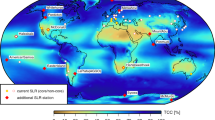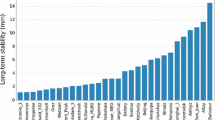Abstract
The International Laser Ranging Service (ILRS) provides weekly solutions for coordinates of Satellite Laser Ranging (SLR) stations coordinates, geocenter coordinates, as well as Earth rotation parameters with a daily resolution. The ILRS standard solution is an important contribution to the International Terrestrial Reference Frame (ITRF). As of today, it is derived from SLR observations to the pairs of LAGEOS and Etalon satellites exclusively. In this paper, the effect of altering the tracking strategy for the LAGEOS and Etalon satellites on the weekly ILRS standard solution is studied. This is done by simulating various tracking scenarios and by comparing the parameters of the solutions for each scenario. In particular, the focus lies on redistributing observation time between the LAGEOS and Etalon satellites as a possible optimization for the tracking scheduling. By this, the current tracking capability of each station is taken into account with no change of the overall tracking activity to LAGEOS and Etalon. It is shown that the quality of the solution for the ITRF-relevant parameters is not significantly degraded when reducing the number of observations to LAGEOS by up to 20% with respect to the number of available normal points in 2016. The vacant tracking capability obtained from the reduction of LAGEOS observations may be used to increase the number of measurements to Etalon by a factor of three. This leads to nearly 10% improvement of the recovery of Earth rotation parameters within the combined LAGEOS–Etalon solution. With our study, we contribute to the ongoing discussions regarding tracking strategies for SLR stations within the ILRS. In particular, the stations could adjust their individual tracking priorities according to these results in the future without major investments or the need for new infrastructure.

























Similar content being viewed by others
Notes
Which is what will be done by the ILRS moving forward.
References
Altamimi Z, Rebischung P, Mativier L, Xavier C (2016) ITRF2014: a new release of the International Terrestrial Reference Frame modeling nonlinear station motions. J Geophys Res Solid Earth. https://doi.org/10.1002/2016JB013098
Andritsch F, Grahsl A, Dach R, Jäggi A (2016) Simulation of realistic SLR observations to optimize tracking scenarios. In: Proceedings of the 20th International Workshop on Laser Ranging, 10–14 October 2016, Potsdam, Germany
Appleby G, Rodríguez J, Altamimi Z (2016) Assessment of the accuracy of global geodetic satellite laser ranging observations and estimated impact on ITRF scale: estimation of systematic errors in LAGEOS observations 1993–2014. J Geod. https://doi.org/10.1007/s00190-016-0929-2
Bizouard C, Gambis D (2012) The combined solution C04 for Earth Orientation parameters consistent with International Terrestrial Reference Frame 2008. Observatoire de Paris, Paris, France
Dach R, Lutz S, Walser P, Fridez P (eds) (2015) Bernese GNSS Software Version 5.2. User manual. University of Bern, Bern Open Publishing, Astronomical Institute. ISBN 978-3-906813-05-9. https://doi.org/10.7892/boris.72297
DGFI (2016) Recent results from SLR data quality control. http://ilrs.dgfi.tum.de/quality/weekly_biases/. Accessed May 2017
James F (1994) RANLUX—a FORTRAN implementation of the high-quality pseudrandom number generator of Luscher. Comput Phys Commun 79(1):111–114
Kehm A, Bloßfeld M, Pavlis E, Seitz F (2018) Future global SLR network evolution and its impact on the terrestrial reference frame. J Geod. https://doi.org/10.1007/s00190-017-1083-1
Knuth D (1997) The art of computer programming, volume 2: seminumerical algorithms, 3rd edn. Section 3.2.1: the linear congruential method. Addison-Wesley, Boston, pp 10–26. ISBN 0-201-89684-2
Marsaglia G, Bray T (1964) A convenient method for generating normal variables. SIAM Rev 6(3):260–264
Matsumoto M, Nishimura T (1998) Mersenne twister: a 623-dimensionally equidistributed uniform pseudorandom number generator. ACM Trans Model Comput Simul 8:3–30
Nishimura T (2000) Tables of 64-bit Mersenne twisters. ACM Trans Model Comput Simul 10:348–357
Noll C, Pearlman M, Torrence M (2015) Summary of results from ILRS GNSS tracking campaigns (2014–2015). In: Presented at the, (2015) ILRS Technical Workshop, 24–30 October 2015. Matera, Italy
Otsubo T, Matsuo K, Aoyama Y et al (2016) Effective expansion of satellite laser ranging network to improve global geodetic parameters. Earth Planets Space. https://doi.org/10.1186/s40623-016-0447-8
Pavlis E, Kuzmicz-Cieslak M (2008) SLR and the next generation global geodetic networks of low satellites. In: Schilliak S (ed) The 16th International Workshop on Laser Ranging, 13–17 October 2008. Poznan, Poland
Pearlman M, Degnan J, Bosworth J (2002) The international laser ranging service. Adv Space Res 30(2):135–143
Pearlman M, Bianco G, Merkowitz S, Noll C, Pavlis E, Shargorodsky V, Zhongping Z (2016) ILRS: current status and future challenges. In: Presented at the Fall American Geophysical Union meeting, 06–12 December, San Francisco, CA, USA
Ricklefs R, Moore C (2009) Consolidated laser ranging data format (CRD), version 1.01, October 27 2009. https://ilrs.cddis.eosdis.nasa.gov/docs/2009/crd_v1.01.pdf. Accessed May 2017
Sinclair A, The International Laser Ranging Service (1997) Data screening and normal point formation: re-statement of Herstmonceux normal point recommendation, June 1997. https://ilrs.cddis.eosdis.nasa.gov/data_and_products/data/npt/npt_algorithm.html. Accessed June 2017
Thaller D, Sośnica K, Dach R, Jäggi A, Beutler G (2011) LAGEOS-ETALON solutions using the Bernese Software. In: Mitteilungen des Bundesamtes für Kartographie und Geodäsie Band 48. Proceedings of the 17th International Workshop on Laser Ranging, 16–20 May 2011. Bad Kötzting, Germany
Acknowledgements
This research project was funded by the Swiss National Science Foundation (SNSF) Grant 200020_157062 Swiss Optical Ground Station and Geodynamics Observatory Zimmerwald and relied on the excellent work of the (Pearlman et al. 2002, ILRS) managing, supporting and supplying the SLR data products.
Author information
Authors and Affiliations
Corresponding author
Rights and permissions
About this article
Cite this article
Andritsch, F., Grahsl, A., Dach, R. et al. Simulation of tracking scenarios to LAGEOS and Etalon satellites. J Geod 94, 40 (2020). https://doi.org/10.1007/s00190-019-01327-w
Received:
Accepted:
Published:
DOI: https://doi.org/10.1007/s00190-019-01327-w




